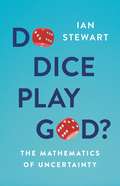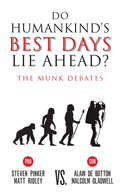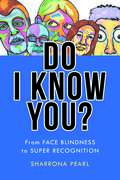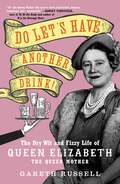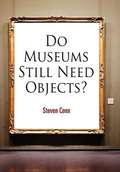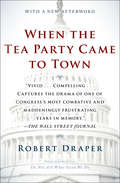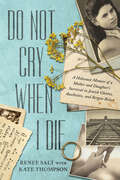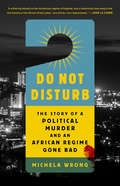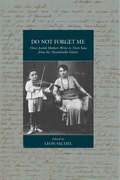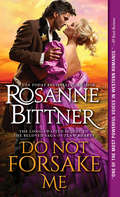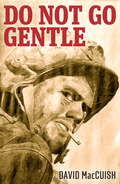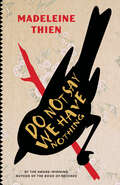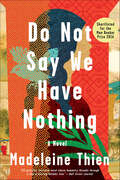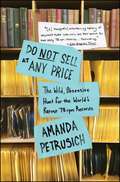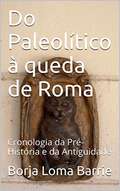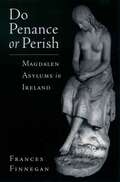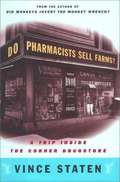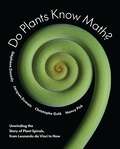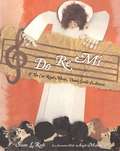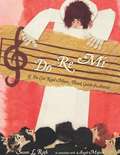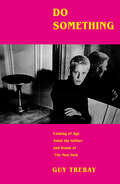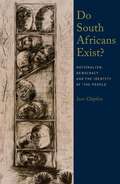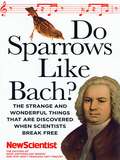- Table View
- List View
Do Dice Play God?: The Mathematics of Uncertainty
by Ian StewartA celebrated mathematician explores how math helps us make sense of the unpredictableWe would like to believe we can know things for certain. We want to be able to figure out who will win an election, if the stock market will crash, or if a suspect definitely committed a crime. But the odds are not in our favor. Life is full of uncertainty --- indeed, scientific advances indicate that the universe might be fundamentally inexact --- and humans are terrible at guessing. When asked to predict the outcome of a chance event, we are almost always wrong. Thankfully, there is hope. As award-winning mathematician Ian Stewart reveals, over the course of history, mathematics has given us some of the tools we need to better manage the uncertainty that pervades our lives. From forecasting, to medical research, to figuring out how to win Let's Make a Deal, Do Dice Play God? is a surprising and satisfying tour of what we can know, and what we never will.
Do Humankind’s Best Days Lie Ahead?: The Munk Debates (The Munk Debates #2015)
by Steven Pinker Malcolm Gladwell Matt Ridley Alain de BottonProgress. It is one of the animating concepts of the modern era. From the Enlightenment onwards, the West has had an enduring belief that through the evolution of institutions, innovations, and ideas, the human condition is improving. This process is supposedly accelerating as new technologies, individual freedoms, and the spread of global norms empower individuals and societies around the world. But is progress inevitable? Its critics argue that human civilization has become different, not better, over the last two and a half centuries. What is seen as a breakthrough or innovation in one period becomes a setback or limitation in another. In short, progress is an ideology not a fact; a way of thinking about the world as opposed to a description of reality.In the seventeenth semi-annual Munk Debates, which was held in Toronto on November 6, 2015, pioneering cognitive scientist Steven Pinker and bestselling author Matt Ridley squared off against noted philosopher Alain de Botton and bestselling author Malcolm Gladwell to debate whether humankind’s best days lie ahead.
Do Let's Have Another Drink!: The Dry Wit and Fizzy Life of Queen Elizabeth the Queen Mother
by Mr. Gareth RussellFor fans of The Crown and Ninety-Nine Glimpses of Princess Margaret, a deliciously entertaining collection of 101 fascinating and funny anecdotes about Queen Elizabeth, the Queen Mother—one for each year of her life.During her lifetime, the Queen Mother was as famous for her clever quips, pointed observations, and dry-as-a-martini delivery style as she was for being a beloved royal. Now, Do Let&’s Have Another Drink recounts 101 (one for each year of her remarkable life) amusing and astonishing vignettes from across her long life, including her coming of age during World War I, the abdication of her brother-in-law and her unexpected ascendance to the throne, and her half century of widowhood as her daughter reigned over the United Kingdom. Featuring new revelations and colorful anecdotes about the woman Cecil Beaton, the high society photographer, once summarized as &“a marshmallow made on a welding machine,&” Do Let&’s Have Another Drink is a delightful celebration of one of the most consistently popular members of the royal family.
Do Museums Still Need Objects?
by Steven Conn"We live in a museum age," writes Steven Conn in Do Museums Still Need Objects? And indeed, at the turn of the twenty-first century, more people are visiting museums than ever before. There are now over 17,500 accredited museums in the United States, averaging approximately 865 million visits a year, more than two million visits a day. New museums have proliferated across the cultural landscape even as older ones have undergone transformational additions: from the Museum of Modern Art and the Morgan in New York to the High in Atlanta and the Getty in Los Angeles. If the golden age of museum-building came a century ago, when the Metropolitan Museum of Art, the American Museum of Natural History, the Philadelphia Museum of Art, the Field Museum of Natural History, and others were created, then it is fair to say that in the last generation we have witnessed a second golden age.By closely observing the cultural, intellectual, and political roles that museums play in contemporary society, while also delving deeply into their institutional histories, historian Steven Conn demonstrates that museums are no longer seen simply as houses for collections of objects. Conn ranges across a wide variety of museum types--from art and anthropology to science and commercial museums--asking questions about the relationship between museums and knowledge, about the connection between culture and politics, about the role of museums in representing non-Western societies, and about public institutions and the changing nature of their constituencies. Elegantly written and deeply researched, Do Museums Still Need Objects? is essential reading for historians, museum professionals, and those who love to visit museums.
Do Not Ask What Good We Do
by Robert DraperThe U.S. House of Representatives--a large, often unruly body of men and women elected every other year from 435 distinct microcosms of America--has achieved renown as "the people's House," the world's most democratic institution, and an acute Rorschach of biennial public passions. In the midterm election year 2010, recession-battered Americans expressed their discontent with a simultaneously overreaching and underperforming government by turning the formerly Democratically controlled House over to the Republicans. Among the new GOP majority were eighty-seven freshmen, many of them political novices with Tea Party backing who pledged a more open, responsive, and fiscally thrifty House. What the 112th Congress instead achieved was a public standing so low--a ghastly 9 percent approval rating-- that, as its longest-serving member, John Dingell, would dryly remark, "I think pedophiles would do better." What happened? Robert Draper explores this question just as he examined the Bush White House in his 2007 New York Times bestselling book Dead Certain: The Presidency of George W. Bush--by burrowing deeply inside the subject, gaining cooperation of the major players, and producing a colorful, unsparingly detailed, but evenhanded narrative of how the House of Representatives became a house of ill repute. Draper's cast of characters spans the full spectrum of political experience and ideologies--from the Democrat Dingell, a congressman since 1955 (though elbowed out of power by the party's House leader, Nancy Pelosi), to Allen West, a black Republican Tea Party sensation, former Army lieutenant colonel, and political neophyte with a talent for equal opportunity offending. While unspooling the boisterous, at times tragic, and ultimately infuriating story of the 112th Congress, Draper provides unforgettable portraits of Gabrielle Giffords, the earnest young Arizona congresswoman who was gunned down by a madman at the beginning of the legislative session; Anthony Weiner, the Democrats' clown prince and self-made media star until the New Yorker self-immolated in a sex scandal; the strong-willed Pelosi and her beleaguered if phlegmatic Republican counterpart, House Speaker John Boehner; the affable majority whip, Kevin McCarthy, tasked with instilling team spirit in the iconoclastic freshmen; and most of all, the previously unknown new members who succeeded in shoving Boehner's Republican Conference to the far right and thereby bringing the nation, more than once, to the brink of governmental shutdown or economic default. In this lively work of political narrative, Draper synthesizes some of the most talked-about breaking news of the day with the real story of what happened behind the scenes. This book is a timely and masterfully told parable of dysfunction that may well serve as Exhibit A of how Americans lost faith in their democratic institutions. *** "Congress will rise June 1st, as most of us expect. Rejoice when that event is ascertained. If we should finish and leave the world right side up, it will be happy. Do not ask what good we do: that is not a fair question, in these days of faction." --Congressman Fisher Ames, May 30, 1796 In Do Not Ask What Good We Do, Robert Draper captures the prophetic sentiment uttered by Fisher Ames over two centuries ago. As he did in writing about President George W. Bush in Dead Certain, Draper provides an insider's book like no one else can--this time, inside the U.S. House of Representatives. Because of the bitterly divided political atmosphere we live in, because of the combative nature of this Congress, this literary window on the backstage machinations of the House is both captivating and timely--revealing the House in full, from the process of how laws are made (and in this case, not made) to the most eye-popping cast of lawmakers Washington has ever seen.
Do Not Cry When I Die: A Holocaust Memoir of a Mother and Daughter's Survival In Jewish Ghettos, Auschwitz, and Bergen-Belsen
by Renee Salt Kate ThompsonOne of the oldest living Holocaust survivors recounts her family&’s imprisonment at Auschwitz and Bergen-Belsen in this moving memoir of love, loss, courage, and hope."A deeply moving memoir, beautifully written and researched." —Lucy Adlington, New York Times bestselling author of The Dressmakers of Auschwitz&“I only survived because of my mother's love.&”When German soldiers invaded Poland in September 1939, it began a six year journey for then-ten-year-old Renee Salt and her mother Sala. Until their liberation in 1945, Renee and Sala were imprisoned in ghettos and concentration camps, including Auschwitz-Birkenau and Bergen-Belsen. The only light in the darkness and brutality for Renee was the unwavering grasp of her mother&’s hand in hers–enduring, against all odds. It was this unbreakable bond, along with a few miracles, that kept Renee alive. Sala&’s staggering courage to defy the will of SS guards saved both her and her daughter from the gas chambers, and the pair survived the deadliest days in Auschwitz&’s history. After suffering the nightmarish conditions at Bergen-Belsen, Renee and her mother were liberated in April 1945–but Sala died soon after they were saved. To this day, Renee attributes her survival to the love and bravery of her beloved mother. Do Not Cry When I Die is an incredibly moving and deeply crucial book that tells the shocking story of one of the oldest Auschwitz-Birkenau and Bergen-Belsen survivors–and the mother&’s love that saved her life.
Do Not Disturb: The Story of a Political Murder and an African Regime Gone Bad
by Michela WrongA powerful investigation into a grisly political murder and the authoritarian regime behind it: Do Not Disturb upends the narrative that Rwanda sold the world after one of the deadliest genocides of the twentieth century.We think we know the story of Africa&’s Great Lakes region. Following the Rwandan genocide, an idealistic group of young rebels overthrew the brutal regime in Kigali, ushering in an era of peace and stability that made Rwanda the donor darling of the West, winning comparisons with Switzerland and Singapore. But the truth was considerably more sinister. Vividly sourcing her story with direct testimony from key participants, Wrong uses the story of the murder of Patrick Karegeya, once Rwanda&’s head of external intelligence and a quicksilver operator of supple charm, to paint the portrait of a modern African dictatorship created in the chilling likeness of Paul Kagame, the president who sanctioned his former friend&’s assassination.
Do Not Forget Me: Three Jewish Mothers Write to Their Sons from the Thessaloniki Ghetto (War and Genocide #32)
by Leon SaltielFollowing the Axis invasion of Greece, the Nazis began persecuting the country’s Jews much as they had across the rest of occupied Europe, beginning with small indignities and culminating in mass imprisonment and deportations. Among the many Jews confined to the Thessaloniki ghetto during this period were Sarina Saltiel, Mathilde Barouh, and Neama Cazes—three women bound for Auschwitz who spent the weeks before their deportation writing to their sons. Do Not Forget Me brings together these remarkable pieces of correspondence, shocking accounts of life in the ghetto with an emotional intensity rare even by the standards of Holocaust testimony.
Do Not Forget Me: Three Jewish Mothers Write to Their Sons from the Thessaloniki Ghetto (War and Genocide #32)
by Leon SaltielFollowing the Axis invasion of Greece, the Nazis began persecuting the country’s Jews much as they had across the rest of occupied Europe, beginning with small indignities and culminating in mass imprisonment and deportations. Among the many Jews confined to the Thessaloniki ghetto during this period were Sarina Saltiel, Mathilde Barouh, and Neama Cazes—three women bound for Auschwitz who spent the weeks before their deportation writing to their sons. Do Not Forget Me brings together these remarkable pieces of correspondence, shocking accounts of life in the ghetto with an emotional intensity rare even by the standards of Holocaust testimony.
Do Not Forsake Me
by Rosanne BittnerExperience the epic, sweeping story of Jake and Miranda Harkner from Bittner's beloved Outlaw Hearts, called by New York Times bestseller Heather Graham "a wonderful, absorbing read, with characters to capture the heart and the imagination".Fate brought them together. His past may tear them apart.Miranda Hayes' life was changed the day she faced down infamous gunslinger Jake Harkner...and walked away with his heart. Their fates have been intertwined ever since. Hunted by the law, fleeing across a savage land, their desperate love flourished despite countless sorrows. Now, twenty-six years later, their family has finally found some measure of peace...balanced on the knife's edge of danger.Jake has spent his years as a U.S. Marshal atoning for sins, bringing law to the land he once terrorized. But no matter how hard he fights the demons of his brutal past, the old darkness still threatens to consume him. Only Miranda keeps the shadows at bay. But when outlaws looking for revenge strike a fatal blow, Jake risks losing the one woman who saw past his hard exterior and to the man inside.He always knew there'd be the devil to pay. He just never realized he might not be the one to bear the ultimate price.
Do Not Go Gentle
by David MacCuishDo Not Go Gentle, first published in 1960, is a poignant novel about the U.S. Marines in World War II. The book focuses on Norman MacLeod, growing up in the tough Depression-era town of Butte, Montana. After his father succumbs to a mining-related disease, young Norman leaves school and also begins working in the copper mines. Following the death of his closest friend in an mine accident and the moving of his mother and sister to relatives back East, Norman enlists in the Marines. The book follows MacLeod through boot camp, life on and off base, and then to the South Pacific where MacLeod and his fellow Marines face both their fears and the Japanese. On leave in the U.S., Norm visits the wife of a killed comrade, and begins a relationship with her. Filled with gritty scenes and no-holds-barred dialog, Do Not Go Gentle remains a minor classic in the field of novels about men at war.
Do Not Say We Have Nothing
by Madeleine ThienAn extraordinary novel set in China before, during and after the Tiananmen Square protests of 1989--the breakout book we've been waiting for from a bestselling, Amazon.ca First Novel Award winner.Madeleine Thien's new novel is breathtaking in scope and ambition even as it is hauntingly intimate. With the ease and skill of a master storyteller, Thien takes us inside an extended family in China, showing us the lives of two successive generations--those who lived through Mao's Cultural Revolution in the mid-twentieth century; and the children of the survivors, who became the students protesting in Tiananmen Square in 1989, in one of the most important political moments of the past century. With exquisite writing sharpened by a surprising vein of wit and sly humour, Thien has crafted unforgettable characters who are by turns flinty and headstrong, dreamy and tender, foolish and wise. At the centre of this epic tale, as capacious and mysterious as life itself, are enigmatic Sparrow, a genius composer who wishes desperately to create music yet can find truth only in silence; his mother and aunt, Big Mother Knife and Swirl, survivors with captivating singing voices and an unbreakable bond; Sparrow's ethereal cousin Zhuli, daughter of Swirl and storyteller Wen the Dreamer, who as a child witnesses the denunciation of her parents and as a young woman becomes the target of denunciations herself; and headstrong, talented Kai, best friend of Sparrow and Zhuli, and a determinedly successful musician who is a virtuoso at masking his true self until the day he can hide no longer. Here, too, is Kai's daughter, the ever-questioning mathematician Marie, who pieces together the tale of her fractured family in present-day Vancouver, seeking a fragile meaning in the layers of their collective story. With maturity and sophistication, humour and beauty, a huge heart and impressive understanding, Thien has crafted a novel that is at once beautifully intimate and grandly political, rooted in the details of daily life inside China, yet transcendent in its universality.
Do Not Say We Have Nothing
by Madeleine ThienWinner of the 2016 Scotiabank Giller Prize and the Governor General's Literary Award for Fiction, shortlisted for the Man Booker Prize, and longlisted for the 2017 Andrew Carnegie Medal for Excellence in Fiction, this extraordinary novel tells the story of three musicians in China before, during and after the Tiananmen Square protests of 1989. Madeleine Thien's new novel is breathtaking in scope and ambition even as it is hauntingly intimate. With the ease and skill of a master storyteller, Thien takes us inside an extended family in China, showing us the lives of two successive generations--those who lived through Mao's Cultural Revolution in the mid-twentieth century; and the children of the survivors, who became the students protesting in Tiananmen Square in 1989, in one of the most important political moments of the past century. With exquisite writing sharpened by a surprising vein of wit and sly humour, Thien has crafted unforgettable characters who are by turns flinty and headstrong, dreamy and tender, foolish and wise. At the centre of this epic tale, as capacious and mysterious as life itself, are enigmatic Sparrow, a genius composer who wishes desperately to create music yet can find truth only in silence; his mother and aunt, Big Mother Knife and Swirl, survivors with captivating singing voices and an unbreakable bond; Sparrow's ethereal cousin Zhuli, daughter of Swirl and storyteller Wen the Dreamer, who as a child witnesses the denunciation of her parents and as a young woman becomes the target of denunciations herself; and headstrong, talented Kai, best friend of Sparrow and Zhuli, and a determinedly successful musician who is a virtuoso at masking his true self until the day he can hide no longer. Here, too, is Kai's daughter, the ever-questioning mathematician Marie, who pieces together the tale of her fractured family in present-day Vancouver, seeking a fragile meaning in the layers of their collective story. With maturity and sophistication, humour and beauty, a huge heart and impressive understanding, Thien has crafted a novel that is at once beautifully intimate and grandly political, rooted in the details of daily life inside China, yet transcendent in its universality.
Do Not Say We Have Nothing: A Novel
by Madeleine ThienWinner of the Scotiabank Giller Prize and the Governor General's Literary Award Finalist for the Booker Prize and the Baileys Women's Prize for Fiction "A powerfully expansive novel…Thien writes with the mastery of a conductor." —New York Times Book Review“In a single year, my father left us twice. The first time, to end his marriage, and the second, when he took his own life. I was ten years old.”Master storyteller Madeleine Thien takes us inside an extended family in China, showing us the lives of two successive generations—those who lived through Mao’s Cultural Revolution and their children, who became the students protesting in Tiananmen Square. At the center of this epic story are two young women, Marie and Ai-Ming. Through their relationship Marie strives to piece together the tale of her fractured family in present-day Vancouver, seeking answers in the fragile layers of their collective story. Her quest will unveil how Kai, her enigmatic father, a talented pianist, and Ai-Ming’s father, the shy and brilliant composer, Sparrow, along with the violin prodigy Zhuli were forced to reimagine their artistic and private selves during China’s political campaigns and how their fates reverberate through the years with lasting consequences.With maturity and sophistication, humor and beauty, Thien has crafted a novel that is at once intimate and grandly political, rooted in the details of life inside China yet transcendent in its universality.
Do Not Sell At Any Price
by Amanda PetrusichThe untold story of a quirky and important subculture: The world of 78rpm records and the insular community that celebrates them--by acclaimed music critic and author Amanda Petrusich, who contributes regularly to Pitchfork, The Oxford American, and The New York Times.Before MP3s, CDs, and cassette tapes, even before LPs or 45s, the world listened to music on 78rpm records--those fragile, 10-inch shellac discs. While vinyl records have enjoyed a renaissance in recent years, good 78s are exponentially harder to come by and play. A recent eBay auction for the only known copy of a particular record topped out at $37,100. Do Not Sell at Any Price explores the rarified world of the 78rpm record--from the format's heyday to its near extinction--and how collectors and archivists are working frantically to preserve the music before it's lost forever. Through fascinating historical research and beguiling visits with the most prominent 78 preservers, Amanda Petrusich offers both a singular glimpse of the world of 78 collecting and the lost backwoods blues artists whose 78s from the 1920s and 1930s have yet to be found or heard by modern ears. We follow the author's descent into the oddball fraternity of collectors--including adventures with Joe Bussard, Chris King, John Tefteller, Pete Whelan, and more--who create and follow their own rules, vocabulary, and economics and explore the elemental genres of blues, folk, jazz, and gospel that gave seed to the rock, pop, country, and hip-hop we hear today. From Thomas Edison to Jack White, Do Not Sell at Any Price is an untold, intriguing story of preservation, loss, obsession, art, and the evolution of the recording formats that have changed the ways we listen to (and create) music.
Do Paleolítico à queda de Roma
by Borja Loma Barrie Beatriz SilvaCrônica ordenada da Pré-História. Hominídeos, culturas e idades. Arte pré-histórica. Crônica da Antiguidade. Mesopotâmia, Egito, China, Índia, Europa e América. Arte, filosofia, ciência, medicina e religião da Antiguidade.
Do Penance or Perish: Magdalen Asylums in Ireland
by Frances FinneganFrances Finnegan traces the development of Ireland's Magdalen Asylums--homes that were founded in the mid-nineteenth century for the detention of prostitutes undergoing reform. The inmates of these asylums were discouraged-and many forcibly prevented-from leaving and sometimes were detained for life. Put to work without pay in adjoining laundries, these women were subject to penance, harsh discipline, enforced silence, and prayer. Their hair was cropped, and they were made to wear drab and shapeless clothing. Forbidden to mention their past lives, their children taken away, the inmates themselves were referred to as children and forced to address the nuns as "Mother." As the numbers of prostitutes began to dwindle, the church looked elsewhere for this free labor, targeting other "fallen" women such as unwed mothers and wayward or abused girls. Some were incarcerated simply for being "too beautiful," and therefore in danger of sin. Others were mentally retarded. Most of them were brought to the asylums by their families or priests. Unbelievably, the last of these asylums was closed only in 1996. Drawing on previously unpublished material, Finnegan presents case histories of individual women and their experiences in Magdalen homes, which claimed some 30,000 women in all. She looks at the social consequences of such a system, and ponders how it was able to survive into the late twentieth century, right through the feminist campaign for women's rights. Do Penance or Perish is the first study of this shameful episode in Irish history.
Do Pharmacists Sell Farms? A Trip Inside the Corner Drugstore
by Vince StatenPart history, part folklore, this collection of marvelous anecdotes and curious facts--from the author of "Did Monkeys Invent the Monkey Wrench?"--takes a witty look at the drugstore, capturing all the sights, sounds, and smells of this rapidly disappearing symbol of small-town charm.
Do Plants Know Math?: Unwinding the Story of Plant Spirals, from Leonardo da Vinci to Now
by Stéphane Douady Jacques Dumais Christophe Golé Nancy PickA breathtakingly illustrated look at botanical spirals and the scientists who puzzled over themCharles Darwin was driven to distraction by plant spirals, growing so exasperated that he once begged a friend to explain the mystery &“if you wish to save me from a miserable death.&” The legendary naturalist was hardly alone in feeling tormented by these patterns. Plant spirals captured the gaze of Leonardo da Vinci and became Alan Turing&’s final obsession. This book tells the stories of the physicists, mathematicians, and biologists who found themselves magnetically drawn to Fibonacci spirals in plants, seeking an answer to why these beautiful and seductive patterns occur in botanical forms as diverse as pine cones, cabbages, and sunflowers.Do Plants Know Math? takes you down through the centuries to explore how great minds have been captivated and mystified by Fibonacci patterns in nature. It presents a powerful new geometrical solution, little known outside of scientific circles, that sheds light on why regular and irregular spiral patterns occur. Along the way, the book discusses related plant geometries such as fractals and the fascinating way that leaves are folded inside of buds. Your neurons will crackle as you begin to see the connections. This book will inspire you to look at botanical patterns—and the natural world itself—with new eyes.Featuring hundreds of gorgeous color images, Do Plants Know Math? includes a dozen creative hands-on activities and even spiral-plant recipes, encouraging readers to explore and celebrate these beguiling patterns for themselves.
Do Re Mi
by Susan L. Roth Angelo MafucciIf you can read musical notes, you can sing any song or play any piece. But musical notes have not always been here. Long ago, songs were memorized. If songs were forgotten, they were lost forever. Thanks to one man, Guido d’Arezzo, music now can last forever.
Do Re Mi: If You Can Read Music, Thank Guido d'Arezzo
by Susan L. RothIf you can read musical notes, you can sing any song or play any piece. But musical notes have not always been here. Long ago, songs were memorized. If songs were forgotten, they were lost forever. Thanks to one man, Guido d’Arezzo, music now can last forever.
Do Something: Coming of Age Amid the Glitter and Doom of '70s New York
by Guy TrebayAn evocative coming-of-age memoir—the story of the education of a wayward wild child and acidhead who, searching for meaning and purpose, found refuge in the demimonde of the ruined but magical metropolis that was New York City in the 1970s.&“In his beautiful memoir, Do Something, Guy Trebay paints a picture of a vanished, pre-AIDS Gotham that&’s both gritty and dazzling.&” —The New York Times Book ReviewBorn in the Bronx, Guy Trebay was raised in an atmosphere of privilege on Long Island&’s North Shore after his entrepreneurial father struck business gold with Hawaiian Surf, a wildly successful cologne company that capitalized on the optimism of the 1960s as marketed to &“an adventurous new breed of men.&’&’ But behind the facade of material prosperity lay the emotional disarray of a household dominated by a charismatic, con artist father, a glamorous yet lost and careless mother, a family haunted by tragedy. By the time Trebay established a foothold at the fringes of Andy Warhol&’s Factory and the diverse artistic tribes that thrived in Manhattan in that pre-digital era, his father had lost his fortune, his younger sister had been arrested for armed robbery and fled underground, the family house was in ashes, and his mother was dead.Unschooled and on his own, Trebay became a striver, wending his way through a seemingly apocalyptic landscape populated by a vibrant cast of characters, including washed-up Hollywood screenwriters of the &’30s; Warhol superstars like Jackie Curtis and Candy Darling; fashion geniuses like Charles James; and emerging artists, filmmakers, writers, designers, photographers, and deejays who would powerfully influence mainstream culture in the decades to come.
Do South Africans Exist?: Nationalism, Democracy and the Identity of ‘the People’
by Ivor ChipkinDo South Africans Exist? Addresses a gap in contemporary studies of nationalism and the nation, providing a critical study of South African nationalism against a broader context of African nationalism in general. Narratives of resistance, telling of African peoples oppressed and exploited, presume that ‘the people’ preceded the period of nationalist struggle. This book explores how an African ‘people’ came into being in the first place, particularly in the South African context, as a collectivity organised in pursuit of a political – and not simply cultural – end. The author argues that the nation is a political community whose form is given in relation to the pursuit of democracy and freedom, and that if democratic authority is lodged in 'the people', what matters is the way that this 'people' is defined, delimited and produced. He argues that the nation precedes the state, not because it has always existed, but because it emerges in and through the nationalist struggle for state power. Ultimately, he encourages the reader to re-evaluate knee-jerk judgements about the failure of modernity in Africa.
Do Sparrows Like Bach?: The Strange and Wonderful Things that Are Discovered When Scientists Break Free
by New ScientistFrom the same editors that brought you Why Don't Penguins' Feet Freeze? and Does Anything Eat Wasps?, an exploration of the weird and wonderful margins of science--the latest volume in the brilliant New Scientist series. Science tells us grand things about the universe: how fast light travels, and why stones fall to earth. But scientific endeavor goes far beyond these obvious foundations. There are some fields we don`t often hear about because they are so specialized, or turn out to be dead ends. Yet researchers have given hallucinogenic drugs to blind people (seriously), tried to weigh the soul as it departs the body, and planned to blast a new Panama Canal with an atomic weapon. Real scientific breakthroughs sometimes come out of the most surprising and unpromising work. Do Sparrows Like Bach? is about the margins of science--investigating everything from what it`s like to die to exploding pants and recycled urine. Who on earth would burn off their beard with a laser? Produce a fireproof umbrella that doubles as a parachute? Replace sniffer dogs with gerbils? Could a chemical component of flatulence be the next Viagra? Do sparrows (and even fish for that matter) prefer Bach to Led Zeppelin? The editors at New Scientist magazine have the answers to all these questions and more in this celebration of outrageous, outlandish, and brilliant discoveries on the fringes of scientific research. This extraordinary collection is an astonishing reminder that even at its most misguided, science is intensely creative, often hilarious, and can spark the imagination like nothing else.
